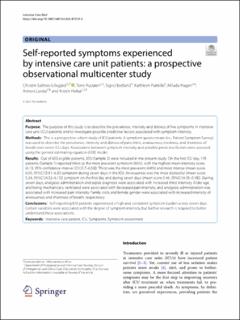| dc.description.abstract | Purpose: The purpose of this study is to describe the prevalence, intensity and distress of five symptoms in intensive
care unit (ICU) patients and to investigate possible predictive factors associated with symptom intensity.
Methods: This is a prospective cohort study of ICU patients. A symptom questionnaire (i.e., Patient Symptom Survey)
was used to describe the prevalence, intensity and distress of pain, thirst, anxiousness, tiredness, and shortness of
breath over seven ICU days. Associations between symptom intensity and possible predictive factors were assessed
using the general estimating equation (GEE) model.
Results: Out of 603 eligible patients, 353 (Sample 2) were included in the present study. On the first ICU day, 195
patients (Sample 1) reported thirst as the most prevalent symptom (66%), with the highest mean intensity score
(6.13, 95% confidence interval (CI) [5.7–6.56]). Thirst was the most prevalent (64%) and most intense (mean score
6.05, 95%CI [5.81–6.3]) symptom during seven days in the ICU. Anxiousness was the most distressful (mean score
5.24, 95%CI [4.32–6.15]) symptom on the first day and during seven days (mean score 5.46, 95%CI [4.95–5.98]). During
seven days, analgesic administration and sepsis diagnosis were associated with increased thirst intensity. Older age
and being mechanically ventilated were associated with decreased pain intensity, and analgesic administration was
associated with increased pain intensity. Family visits and female gender were associated with increased intensity of
anxiousness and shortness of breath, respectively.
Conclusions: Self‑reporting ICU patients experienced a high and consistent symptom burden across seven days.
Certain variables were associated with the degree of symptom intensity, but further research is required to better
understand these associations. | en_US |

